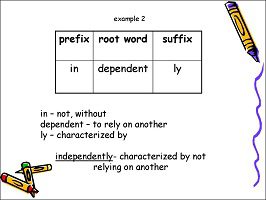Affixes in English Grammar with examples
Affixes
The affixes are particles that bind to a word (or the root of a word) and are derived words, changing the meaning of the word to which they bind. For example a morph- (formless), cinema- philia (love of film). Depending on their location with respect to the word they can be: Affixes in English
1-Prefixes. Morphemes precede the root of the word.
-
- Derivative prefixes. They form a word of different meanings. For example antivirus.
- Inflectional prefixes. They express another grammatical category
2-Suffixes. Morphemes are added after the root of the word.
-
- Diminutives. They indicate smallness or affective closeness.
- Augmentatives . They indicate amazement or an exaggerated characteristic.
- Contemptuous. Pejoratively degrade the word they modify.
3-Infixes. They are inserted inside the root of the word.
Affixation
There are different ways of forming words in English. In this material, we detail the most common of them – the affixation ( affixation ). This is a way of forming new words by adding structural units to the base – morphemes ( a morpheme ) or, as they are also called, affixes ( an affix ). There are two types of affixation:
But it often happens that both are added.
To learn how to work with affixation, it is important to have an understanding of the three parts of a word: root/stem, suffix, and prefix. In this material, we will consider those principles that will help you generate new words from already known ones, as well as obtain information about unfamiliar words, simply by analyzing their structure. Affixes in English
At the very beginning, I would like to address the “experts” and theory lovers and remind me that I write and explain in simple language for ordinary people who want to solve a specific practical problem – to learn to speak English. Therefore, there will be no theoretical digressions, an abundance of terms. My goal is to make the complex understandable and ready to use, even for those who have just started learning English.
Root and base words
Of course, the main meaning of the word is in its foundation, or in its root. The concepts “base” and “root” are often considered identical, but there is a nuance that distinguishes them.
The base word ( base word ) is usually an independent word (for example, a verb or noun ), to which prefixes and suffixes are added, however, the base can function in its pure form, without affixes.
Examples of such words:
Develop – Develop
Manage – Manage
Act – Play a Role
A root ( root word ) is a combination of several letters that carries a certain general meaning and can serve to form individual stems.
Many roots in English are of Greek or Latin origin, and do not exist by themselves, in separate words – they must always be accompanied by a suffix or a prefix, or even another word in order to form a full-valued lexical unit.
For what I love the Latin and Greek word stems – they are very similar in many languages, it is easy to build associations with them and remember. Even if you have never paid attention to the roots and their meanings, they are recognized intuitively. Take a look at the examples below and I’m sure you can decode many values, although you may never have thought about them before:
1-Aud – to hear ( hear )
audible – audible
2-Bene – a good ( good )
benevolent – benevolent, supportive
beneficial – wholesome, benevolent
3-Corp – body ( old body )
corpse – corpse
4-Dict – say ( say )
dictate – dictate
5-Gen – birth ( birth )
genetics – genetics
generate – produce
6-Sen – old, senior ( old )
senior – senior, elderly
How affixation works
So, now you know what an English word constructor is, but keep in mind that this constructor does not work in every case. You cannot take any stem and stick any suffix or prefix to it.
In addition, sometimes dictionaries give several variants of suffixes and prefixes for one stem – which one is correct? Usually, the one that is most commonly used. Affixes in English
To understand the principle of working with affixation and learn how to apply it effectively in learning a language and speaking English, I recommend that you observe words and learn how to dissect words. Seeing a new word formed with the help of affixation, immediately divide it mentally into parts. If the word is completely unfamiliar, I recommend starting the analysis from the end of the word:
- What is the suffix of the word?
Which part of speech does he point to?
What meaning does it convey? - Where is the base?
What does it mean? - What is the prefix of the word?
What meaning does it convey?
If you have been studying English for several years, then at least one of the elements you will recognize, it will already give some information about the word if it is about perception. Over time, having accumulated a lot of experience in such an analysis, you yourself will not notice how several dozen or even hundreds of new words will enter your active use, which is not actually new but formed from old ones.
Now imagine that you have a set of roots and stems of words, a set of suffixes for different parts of speech, prefixes with different meanings, and an understanding of how to combine them. Just imagine how many new words you can form and use! Affixes in English
